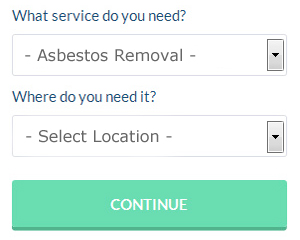Asbestos Removal Great Dunmow Essex (CM6): Every year, according to the accepted HSE (Health & Safety Executive) figures, over five thousand people die from health problems brought on by asbestos. If your Great Dunmow property or home needs the removal and disposal of some asbestos you'll need to seek expert help in order to do this in a safe way. If you're working on an old building and stumbled on a substance that you suspect could be asbestos, you must cease work right away and seek the advice of an experienced asbestos professional. An asbestos removal contractor in Great Dunmow will quickly be able to evaluate the situation and offer advice on the correct technique for disposal.
It could be discovered during the inspection that you do not need to use a HSE licensed contractor for the asbestos removal. But, with asbestos fibres and dust able to do long term damage and cause prolonged consequences on people's health, it's always better to be safe than sorry. Always use a certified Great Dunmow asbestos removal contractor who follows the necessary Health & Safety Executive guidelines and that has had training in the industry.
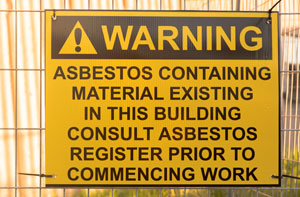
THE HEALTH DANGERS OF ASBESTOS
Asbestos when it's left undisturbed doesn't carry any health risks. Only when it is abraded or cut can tiny asbestos particles or fibres be released into the atmosphere. If these fibres are breathed in they find their way into the lungs and get trapped, causing a disease called asbestosis. These fibres or particles are also a contributing factor to the development of lung cancer and mesothelioma.
Asbestos fibres cause irreversible scarring to the lungs, and there is no known cure for asbestosis.
The symptoms of asbestosis could include:
- Wheezing
- Pain in Your Shoulder or Chest
- Persistent Cough
- Severe Shortness of Breath
- Extreme Fatigue
If you experience one or more of these symptoms and you've been exposed to asbestos over a period of time, you must contact your GP and seek their advice.
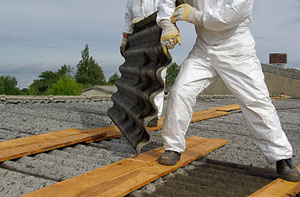
CONSIDERATIONS WHEN DEALING WITH ASBESTOS
Properties and structures that were constructed from 1945 - 1985 are more likely to contain asbestos than those built after this; asbestos was banned in the construction industry in Britain in 1999. Many older homes and properties may therefore contain asbestos in some section of the structure. It was used in items such as pipe lagging, ceiling tiles and boiler insulation and was also used in the form of a spray as the ideal fire-proofing and insulation material.
If you do find asbestos in your home in Great Dunmow, it doesn't automatically present an immediate danger or threat. It is only when asbestos materials are disturbed that they can become dangerous. In truth, in some structures it is far better to leave the asbestos in situ and use precautions to ensure it's not going to be damaged. You ought to ask for help from a professional asbestos removal company if you are unsure about the risks posed by any asbestos materials in your home in Great Dunmow.
Not all asbestos products are considered high risk and require certified removal contractors to deal with them. Due to how various asbestos components are manufactured and their likelihood of releasing harmful fibres into the air, products like loose fill cavity insulations, pipe lagging and asbestos insulation boards are considered higher risk to health than asbestos cement sheets and roofing panels. Irrespective of the risk associated with asbestos, a registered asbestos removal contractor in Great Dunmow can safely ascertain, remove and dispose of any dangerous materials that are discovered in your property.
If the removal of asbestos has a requirement for a HSE license holder to complete the task, then the local authority or the Health & Safety Executive has to be informed. The Control of Asbestos Regulations 2012 are the guidelines that your chosen asbestos removal firm must follow in order to protect work areas and individuals from asbestos fibre and particles.
Be warned it's an offence punishable by law to perform anything deemed to be licensed work without having a license.
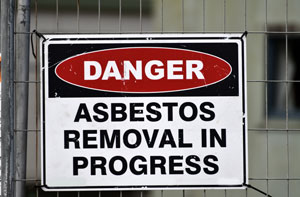
THE DISPOSAL OF ASBESTOS
Whenever the asbestos products have been stripped away from your Great Dunmow property they must be handled as hazardous waste. There are demanding practices needed to dispose of any kind of hazardous waste, especially that which contains asbestos products. An experienced asbestos removal company in Great Dunmow will comply with all guidelines and regulations provided by the HSE and local authority.
If the asbestos has been damaged, or if it is loose fibre asbestos, it has to be transferred as outlined by the Carriage of Dangerous Goods Act 2009. For safe and secure transportation of these dangerous materials, a waste carrier's license is required and the waste can only be disposed of in a government approved hazardous waste facility. To put your mind at rest the use of a registered Great Dunmow asbestos removal company gives them the responsibility of following all guidelines and rules, including the safe-keeping and storage of all disposal documents for a minimum of three years just in case it is required for reference later.
STAGES OF WORK
Before any items that might contain asbestos are removed from your Great Dunmow property, it's good practice to verify the substances that are involved. Specialist testing can indicate the presence or absence of asbestos materials and the licensing which is necessary for the removal and disposing of it. If you decide not to complete a professional inspection on an older home, you have to presume there is asbestos present and take all the necessary precautions.
An asbestos removal contractor may recommend a surveyor to check your premises, but this individual must be independent and not employed by or a partner in that business.
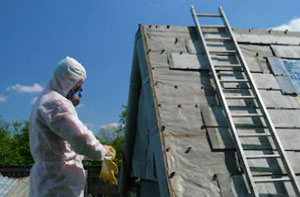
If it is decided that you need a Health and Safety Executive registered asbestos firm for the removal and disposal required, it is a legal requirement to notify the Health & Safety Executive of any work to be undertaken at least fourteen days in advance. An authorised asbestos removal contractor will supply all the necessary documentation which should include: 1. A prepared work declaration of the regulations, legislation and guidelines for the assignment. 2. All work licenses, hazardous waste disposal testing & training, risk assessments and medical certificates for the specific task. 3. A definitive strategy for sample testing and also clearing up after the task. 4. After the four stage clearance procedure have been completed, the Certificate of Reoccupation from an accredited organisation will be presented.
The asbestos company will also supply all personal protective equipment (PPE) for their workforce and make sure that all waste materials are correctly stored and transferred to a registered waste disposal site.
AFFILIATIONS, QUALIFICATIONS and PROFESSIONAL ORGANISATIONS
Before you pick out an asbestos removal contractor in the Great Dunmow area, confirm their affiliation and membership of professional associations within the asbestos industry.
ARCA - The Asbestos Removal Contractors Association (ARCA) is the United Kingdom's primary professional organisation which represents companies working within the asbestos sector. Offering an extensive package of support, training and guidance, ARCA is responsible for the promotion of safe working practices, professionalism and reliability for its members.
UKATA - The UK Asbestos Training Association (UKATA) is a not for profit agency that's focused on improving standards throughout the asbestos industry, by offering the finest quality training. They also offer immediate validation of individual contractor's and company accreditations by way of their searchable, online database.
ATaC - The Asbestos Testing and Consultancy Association (ATac) provides qualifications and advice for asbestos analysts and surveyors. ATaC is a certified UKAS associate and offers recognition to its membership in this specialist area.
Asbestos removal sevices are available in Great Dunmow itself and additionally in neighbouring towns and villages like Stebbing, Black Notley, Duckend Green, Little Easton, Great Easton, Churchend, Great Notley, Takeley, Bambers Green, Felstead, Dunmow, Little Canfield, Barnston, Little Dunmow, Great Waltham, and in these postcodes: CM6 1WU, CM6 3WD, CM6 1AL, CM6 1LN, CM6 1TN, CM6 1HT, CM6 1XU, CM6 1BD, CM6 1UB, and CM6 1ZE. Local Great Dunmow asbestos removal companies will likely have the telephone code 01371 and the postcode CM6. Checking this can confirm that you access locally based providers of asbestos removal. Great Dunmow householders are able to utilise these and many other comparable services. By clicking on the "Quote" banner you can obtain asbestos removal quotations from local specialists.
Types of Asbestos
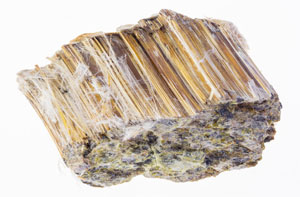
Naturally occurring on all of the world's continents, asbestos is a fibrous material that was used in the manufacturing and construction industries from the latter part of the 19th century until it was banned altogether in Britain in 1999. Belonging to the amphibole and serpentine groups, there are 6 different kinds of asbestos in all - chrysotile, crocidolite, amosite, anthophyllite, actinolite and tremolite.
For the purpose of this short article we'll just be considering the three primary types that were most widely used in products found in the United Kingdom. Those are: crocidolite, chrysotile and amosite.
Amosite (Brown Asbestos) - Part of the Amphibole family of silicate minerals, Amosite (grunerite or brown asbestos), was mostly mined in South Africa and was frequently used in the manufacture of ceiling tiles, pipe insulation, insulating board, fire protection, roofing materials and cement sheets.
Chrysotile (White Asbestos) - Also know as white asbestos, chrysotile asbestos was the most widely used form of this deadly material. It was used in the manufacture of pipe & duct insulation, boiler seals, brake linings and gaskets, and in the floors, ceilings, roofs, insulation and walls of many Great Dunmow homes and buildings. Chrysotile is part of the Serpentine family of minerals.
Crocidolite (Blue Asbestos) - Part of the Amphibole family of minerals, crocidolite (or blue asbestos), is considered to be the most dangerous of all the asbestos minerals. It is frequently found in cement products, pipe lagging, spray-on coatings and plastics, and was widely used for insulating steam engines.
Ground Remediation Services Great Dunmow
Ground remediation refers to the process of cleaning up and restoring contaminated soil or groundwater. The process is commonly employed in areas that have been contaminated with harmful substances, including industrial chemicals, heavy metals or pesticides. Ground remediation is carried out with the aim of reducing the concentration of pollutants present to an acceptable level, thereby restoring the safety of the land. The methods used for ground remediation can vary, with some common techniques including soil washing, excavation and bioremediation. The approach employed will vary based on the type and degree of contamination, as well as the environmental conditions. Ground remediation is a lengthy and often complex process, requiring expert skills and specialised equipment. Partnering with industry experts is crucial for ensuring the remediation process is completed safely and effectively.
Asbestos Testing Great Dunmow

Asbestos sampling involves the analysis of dubious materials to discover whether or not they contain any asbestos. A sample should be taken of any questionable materials that you may have in your premises in Great Dunmow, which can then be sent away to an expert for analysing. Amongst the most widespread asbestos containing materials found in Great Dunmow buildings are: insulation board, textured coatings, pipe coverings, garage roofs, roof tiles, vinyl tiles and sealants. If you are doing major restoration work on a building that was erected before 2000 you must perform asbestos sampling on any suspect materials.
In accordance with the Control of Asbestos Regulations 2012, only UKAS certified laboratories (ISO 17025) are permitted to undertake testing on ACMs. Whilst searching on the web for "asbestos testing" or "asbestos sampling", you might have come across asbestos testing kits, which may seem more appealing and less costly than going through the process of employing a professional service. However, it is neither reliable nor advisable to use these for ascertaining whether materials in your premises contain asbestos. Stick with the professionals and use a certified asbestos testing contractor, for safe and reliable sampling and testing. (Tags: Asbestos Testing Kits Great Dunmow, Asbestos Tests Great Dunmow, Asbestos Sampling Great Dunmow, Asbestos Testing Great Dunmow).
Asbestos Encapsulation Great Dunmow
It's not always necessary to actually remove asbestos when it is found inside a property in Great Dunmow, in some cases it might be possible to use a process known as asbestos encapsulation instead. This is a procedure that involves encasing the asbestos containing materials (ACM's) in a protective membrane to both stop the potentially hazardous asbestos fibres from escaping and protect the ACM's from being compromised. This layer could be a cloth wrap, a rigid sheet or a sprayed or painted coating. A detailed asbestos risk assessment will have to be accomplished on the ACM's in order to confirm whether or not they can be encapsulated. (Tags: Asbestos Surveys Great Dunmow, Asbestos Risk Assessments Great Dunmow, Asbestos Encapsulation Great Dunmow)
Asbestos Tile Removal Great Dunmow
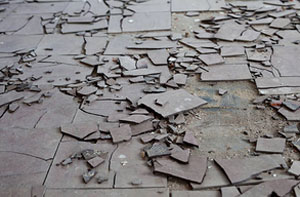
Careful handling and proper safety measures are necessary when undertaking the hazardous and challenging process of asbestos floor tile removal. Asbestos, a naturally sourced mineral, was commonly used in flooring tiles in the past owing to its durability and heat-resistant qualities. There has been a link between various health conditions, such as mesothelioma, asbestosis and lung cancer, and the inhalation of airborne asbestos fibres.
To prevent exposure to the harmful fibres, removing asbestos floor tiles requires specialised protective clothing and equipment, such as gloves, disposable coveralls and respirators. The guidelines issued by regulatory bodies like the HSE must be followed to ensure the safe removal and disposal of asbestos waste and floor tiles.
Licensed professionals with the appropriate experience and training should be the only ones to carry out the removal of asbestos floor tiles to reduce the risk of asbestos exposure.
Artex Removal
It was fairly common back in the nineteen seventies and eighties, for both DIY fanatics and tradespeople, to apply Artex to the ceilings and walls of homes in Great Dunmow. Any visible flaws, cracks and imperfections in these surfaces were quickly hidden by the textured finish of this handy product. On ceilings, Artex often replaced the 60s fashion of polystyrene tiles which became well known as a serious fire risk.

Ironically, given that Artex contained asbestos, one dangerous material was purely being exchanged for another. The true dangers of asbestos in building materials weren't fully understood at this stage of course, and it was not banned in the UK until the late 1990s. Providing that this material is not disturbed in any way, it's mostly harmless, and that's fortunate, given that there are still countless dwellings in Great Dunmow which have Artex coated walls and ceilings.
Although the removal of textured coatings is classed as non-licenced work, if you have a dwelling in Great Dunmow that has Artex on the ceilings, you mustn't try to remove it yourself. The safest way to get your Artex removed is to get in touch with a local Great Dunmow asbestos removal company, who will go through the proper procedures for safely sampling and removing the offending Artex from your property.
Asbestos Air Monitoring
Asbestos air monitoring is a comprehensive procedure that is employed to ensure the safety of air quality in environments that could potentially be contaminated with airborne asbestos fibres. The process of systematically sampling and analysing the air is used to determine the presence of these dangerous fibres. The goal is to measure the level of airborne asbestos fibres and assess whether they pose a threat to the health of occupants, residents or personnel.
Qualified asbestos professionals perform air monitoring, using specialised equipment. Areas where asbestos disturbance or removal is occurring have air sampling devices carefully placed in them. Air samples are collected by these devices over a set period. After collection, the samples are analysed in approved laboratories to determine the quantities and types of asbestos fibres present in the area.
Utmost importance is attached to air monitoring, which serves several critical purposes:
- Risk Assessment: Asbestos air monitoring helps to determine the level of asbestos exposure risk during activities such as asbestos removal, maintenance or renovation, which is essential for safety. This enables informed decisions to be made about the need for protective measures.
- Regulatory Compliance: Asbestos air monitoring is an important tool for ensuring compliance with asbestos management regulations and for documenting the safety measures taken, and it is required by law in many countries, including the United Kingdom.
- Worker Safety: Individuals involved in asbestos-related work, such as asbestos removal specialists, maintenance staff, and construction workers, can rely on air monitoring to provide real-time data on the effectiveness of containment measures and the need for personal protective equipment.
Asbestos Removal Tasks Great Dunmow
Asbestos removal contractors will be able to help with asbestos replacement, asbestos surveying, asbestos removal quotes, fly tipping clearance Great Dunmow, Artex asbestos removal Great Dunmow, the removal of asbestos ceiling tiles, artex asbestos survey, hazardous material management, asbestos risk assessment, the removal of asbestos, asbestos removal services, the identification of ACMs (asbestos containing materials), asbestos flue removal, asbestos roof tile removal, asbestos sampling in Great Dunmow, asbestos insulation removal, air testing in Great Dunmow, asbestos identification, Artex removal, asbestos inspections, lead paint testing Great Dunmow, residential asbestos survey, commercial asbestos survey, reinstatement services, hazardous waste removal in Great Dunmow, white asbestos removal, asbestos consulting, house clearance, blue asbestos removal, asbestos management Great Dunmow, asbestos strip-outs Great Dunmow, asbestos air monitoring, environmental cleaning, corrugated asbestos removal Great Dunmow, and other hazardous waste related work. Listed are just an example of the duties that are conducted by those installing asbestos removal. Great Dunmow professionals will be delighted to keep you abreast of their whole range of services.
Products That Could Contain Asbestos
- Lagging
- Asbestos Cement Products (Cladding, Roof Sheets and Downpipes)
- Composite Materials (Toilet Cisterns, Window Sills and Bath Panels)
- Gaskets and Rope Seals (Especially on Old Boilers and Stove Doors)
- Old Floor Tiles
- Textured Coatings (Older Forms of Polytex and Artex)
- Asbestos Insulating Boards (Fire Door Panels, Partition Walls and Ceiling Tiles
- Roofing Felt (Especially on Garages and Outbuildings)
- Textiles (Protective Overalls, Fire Blankets and Heat-Resistent Gloves)
- Spray Coatings on Ceilings, Walls, Beams and Columns
Asbestos Removal Near Great Dunmow
Also find: Barnston asbestos removal, Bambers Green asbestos removal, Great Waltham asbestos removal, Little Dunmow asbestos removal, Great Notley asbestos removal, Stebbing asbestos removal, Black Notley asbestos removal, Takeley asbestos removal, Felstead asbestos removal, Churchend asbestos removal, Little Easton asbestos removal, Duckend Green asbestos removal, Dunmow asbestos removal, Little Canfield asbestos removal, Great Easton asbestos removal and more. The majority of these locations are covered by companies who do asbestos removal. Business and home owners in these localities can obtain estimates for asbestos removal by clicking here.
Asbestos Removal Services Great Dunmow
- Hazardous Waste Removal
- Asbestos Removal Prices
- Asbestos Testing
- Asbestos Surveys
- Asbestos Removal Quotes
- Biohazard Removal
- Asbestos Inspections
- Asbestos Removal
- Hazardous Material Removal
- Commercial Asbestos Removal
- Residential Asbestos Removal
- Domestic Asbestos Removal
- Asbestos Disposal
- Asbestos Removal Contractors

Other Great Dunmow Tradesmen: When you are looking for asbestos removal in Great Dunmow, you may also need the services of other tradesmen, for example you might need removal services in Great Dunmow, a carpenter in Great Dunmow, roof cleaning in Great Dunmow, a flooring contractor in Great Dunmow, timber treatment in Great Dunmow, a painter & decorator in Great Dunmow, an electrician in Great Dunmow, a landscaper in Great Dunmow, a cleaner in Great Dunmow, a roofer in Great Dunmow, a loft conversion specialist in Great Dunmow, a builder in Great Dunmow, demolition services in Great Dunmow, waste removal in Great Dunmow, a dry lining specialist in Great Dunmow, garden clearance in Great Dunmow, a plasterer in Great Dunmow, a handyman in Great Dunmow, SKIP HIRE in Great Dunmow, a bricklayer in Great Dunmow, or some other Great Dunmow tradespeople.
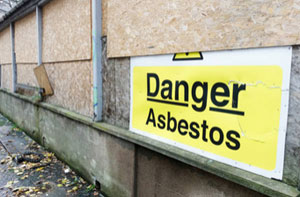 Asbestos Removal Great Dunmow
Asbestos Removal Great Dunmow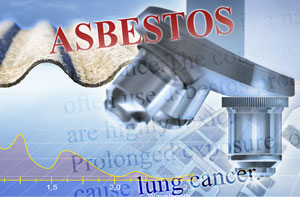 Asbestos Removal Near Great Dunmow
Asbestos Removal Near Great Dunmow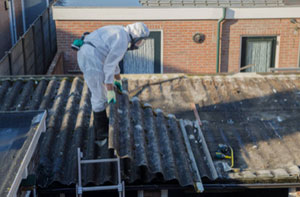 Asbestos Removal Companies Great Dunmow
Asbestos Removal Companies Great DunmowAsbestos Removal Jobs Great Dunmow: View asbestos removal jobs near Great Dunmow here: Great Dunmow Asbestos Removal Jobs
For the best local Great Dunmow info click here
More: Asbestos Inspections, Asbestos Management, Asbestos Disposal, Asbestos Roof Removal, Asbestos Removal, Removal Contractors, Artex Removal, Asbestos Risk Management, Asbestos Management, Cheap Asbestos Removal, Environmental Cleaning, Cheap Waste Removal, Asbestos Testing, Asbestos Survey, Asbestos Inspections, Asbestos Management, Asbestos Survey, Asbestos Disposal, Asbestos Encasement, Asbestos Risk Management, Asbestos Ceiling Removal, Asbestos Removal Services, Cheap Asbestos Removal, Asbestos Encapsulation, Hazardous Waste Removal, Asbestos Management, Asbestos Encapsulation, Hazardous Waste Disposal, Removal Contractors, Asbestos Risk Assessment, Cheap Asbestos Removal, Removal Contractors, Artex Removal, Asbestos Encasement, Asbestos Ceiling Removal.
Asbestos Removal in CM6 area, telephone code 01371.
TOP - Asbestos Removal Great Dunmow
Asbestos Disposal Great Dunmow - Asbestos Management Great Dunmow - Asbestos Encapsulation Great Dunmow - Industrial Asbestos Removal Great Dunmow - Asbestos Survey Great Dunmow - Removal of Asbestos Great Dunmow - Asbestos Removal Great Dunmow - Hazardous Material Removal Great Dunmow - Asbestos Removal Companies Great Dunmow




